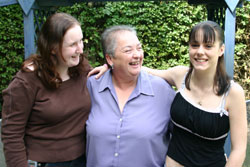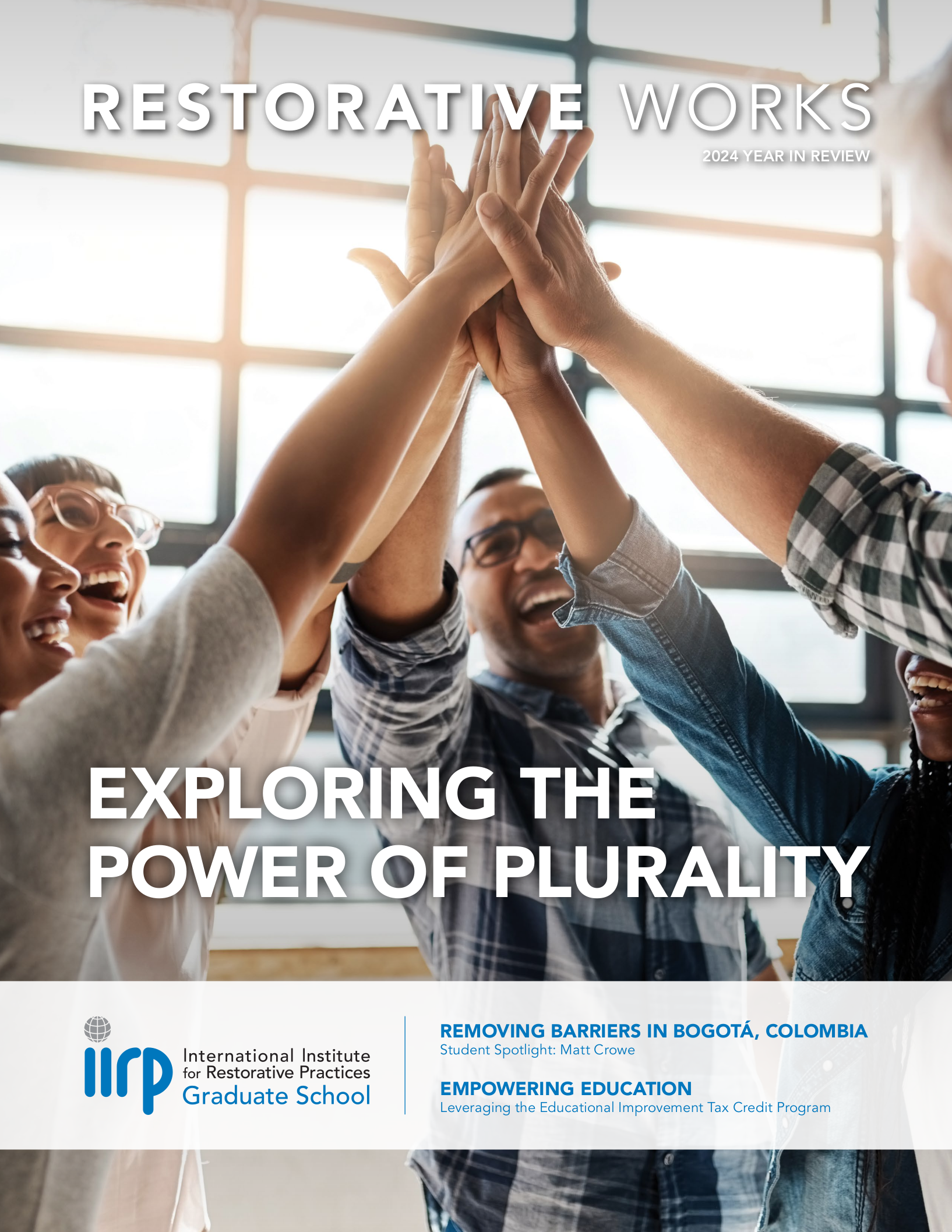News & Announcements
- Details
- Written by Mary Shafer
“It Definitely Works”John Cutro facilitated a restorative conference in the wake of a violent fight in a McDonald’s restaurant in Albany, New York. Six months later, he conducted “verification and learning” interviews with conference participants. Tracy Coleman, mother of a girl present at the fight, who attended the conference, said, “It [conferencing] definitely works. It made an abundance of difference. It [the conflict] wouldn’t have been resolved this fast.” Her daughter, Chanell, added, “I think they’d still be fighting to this day.” Regarding school mediation efforts in response to the incident, she said, “As soon as we left [mediation] we were fighting again. We didn’t get to talk about what had happened, like we did in the conference.” |
There is promise inherent in conflict. That’s the vision of John Cutro and Dennis Mosley of Albany, New York, restorative practices consultants who are combining their vision with a flexible approach to the emotionally charged process of restorative conferencing. The result is an inner city that’s getting a handle on its school and street violence, while its citizens take back the power to make proactive decisions about their quality of life.
 Missy Oliver (left) and Chanell Coleman (right) were present at the McDonald’s incident. Chanell’s mother, Tracy Coleman (center), attended the conference with her daughter.Restorative conferencing as a dispute resolution tool opens doors to real communication and understanding that remain shut in the face of more traditional methods. Conferencing works because it draws its power from within the community, instead of being imposed upon it from outside.
Missy Oliver (left) and Chanell Coleman (right) were present at the McDonald’s incident. Chanell’s mother, Tracy Coleman (center), attended the conference with her daughter.Restorative conferencing as a dispute resolution tool opens doors to real communication and understanding that remain shut in the face of more traditional methods. Conferencing works because it draws its power from within the community, instead of being imposed upon it from outside.
Cutro previously worked in the New York Capitol Defender’s Office, where he learned that the traditional justice system “is not a system, and it’s ineffective. It’s a process that produces case activities, not justice. It’s adversarial by nature, which causes polarization. Justice is the last thing you’d logically expect to come out of a process like that.”
- Details
- Written by Rodney Skager
This booklet, available at www.beyondzerotolerance.org, was issued as part of a campaign by the California (USA) Statewide Task Force for Effective Drug Education. It advocates restorative practices, as implemented by the IIRP''s SaferSanerSchools program, as a critical piece in its approach to drug education.
- Details
- Written by Crime and Justice Research Centre, Victoria University of Wellington, with Sue Triggs, for the Ministry of Justice
The Crime and Justice Research Centre, Victoria University, Wellington, New Zealand, and the New Zealand Ministry of Justice have released a research evaluation of restorative conferences for juvenile and adult offenders that contains highly positive results. Two-hundred six court-referred conferences, all of which included victim participation (or representation), were evaluated over a one-year period.
From Sanctions to Support: Restorative Practices Transform Homes for Looked-after Children in the UK
- Details
- Written by Laura Mirsky
 Veronica Hart and two Stanfield Home residents
Veronica Hart and two Stanfield Home residents
About four years ago, the Stanfield Home for looked-after children, in Welwyn-Garden City, Hertfordshire, UK, was in crisis. Relationships between staff and children were terrible, and there were many violent incidents, said Stanfield manager Veronica (Ron) Hart. Staff stress was causing big turnover rates and lots of long-term sick leave. Then restorative practices turned things around.
Stanfield consists of two homes, housing six youths each, on one site—one for ages 11-15 and one for ages 13-18 and older. These are youth who can’t live with their family or a substitute (foster) family, due to abuse or neglect, or those with educational, truancy or behavioral problems, placed in the home by county social services.
- Details
- Written by Abbey J. Porter
 CSF youths visit Neshaminy Manor.It’s Saturday morning, and the residents of Neshaminy Manor nursing home in Warrington, Pennsylvania, USA, know what that means. They walk, wheel and shuffle their way into the home’s activity area to take up their regular stations at tables scattered throughout the room.
CSF youths visit Neshaminy Manor.It’s Saturday morning, and the residents of Neshaminy Manor nursing home in Warrington, Pennsylvania, USA, know what that means. They walk, wheel and shuffle their way into the home’s activity area to take up their regular stations at tables scattered throughout the room.
It’s time for cardingo.
The cards/bingo hybrid is a favorite among the residents, and today’s game promises to be especially exciting. As on the first Saturday of every month, the residents are joined by special helpers: teen-agers performing community service through the Community Service Foundation (www.csfbuxmont.org) in Doylestown, Pennsylvania, a sister organization of the IIRP. The boys and girls belly up to the tables next to the residents, where they help to shuffle, deal and read cards. Outside, another group of youngsters is busy weeding a garden.
- Details
- Written by Nancy Riestenberg
Nancy Riestenberg is a prevention specialist with the Minnesota (USA) Department of Education’s Safe and Healthy Learners Unit. She presents workshops on bullying prevention, restorative practices in schools and school climate.
In a recovery school, the students commit to working on recovery from chemical dependency and addiction while becoming successful students. Since all of the students attending the school have been in chemical dependency treatment, the safety of the environment is the first concern of students, their families and staff. Applying restorative principles and the process of the circle has helped one recovery school create a truly respectful, student-centered program.
PEASE Academy (“Peers Enjoying A Sober Education”), located in a church in Minneapolis, Minnesota, was the first recovery high school in the United States, founded in February 1989. During the last several years, through staff training and application, the school has incorporated the circle process and restorative principles into its program. Circles are used on Mondays and Fridays for youth to check in about the highs and lows in their sobriety. All 65 students and about five staff participate in the circles.
- Details
- Written by Mary Shafer
 When I arrived at the Community Service Foundation’s (CSF) foster girls’ group home in Quakertown, Pennsylvania, USA, houseparent Linda Anschuetz showed me into the dining room. She motioned me to a chair by the table, around which six pairs of teen-age eyes—alternately curious and suspicious—focused on me. Who was this stranger who’d arrived in the midst of their safe, carefully structured environment, and what did I want?
When I arrived at the Community Service Foundation’s (CSF) foster girls’ group home in Quakertown, Pennsylvania, USA, houseparent Linda Anschuetz showed me into the dining room. She motioned me to a chair by the table, around which six pairs of teen-age eyes—alternately curious and suspicious—focused on me. Who was this stranger who’d arrived in the midst of their safe, carefully structured environment, and what did I want?
Linda quickly dispelled any misgivings. She told them I was writing about the program and encouraged everyone to introduce themselves and to make me feel welcome. Most of the girls smiled at me. A few looked shy.
Quickly, one of them offered her name and a friendly, “Hi!” The rest, ranging in age from 14 to 17, continued introductions. I detected a range of personality types, from outgoing to withdrawn.
- Details
- Written by Diane Pretasky
The July 2005 American edition of "Good Housekeeping", one of the top-selling magazines in the U.S., features a story on restorative justice called "Putting Out the Fire." The article tells the story of a family in La Crosse, Wisconsin, USA, whose house was destroyed in a random act of arson by two teenage boys. The article is reprinted here (PDF), with permission.
- Details
- Written by Abbey J. Porter
 Flags from many nations stand outside the U.N. Crime Congress plenary hall.Restorative justice is playing an increasingly significant role in countries all over the globe, and its influence will likely continue to grow. That message emerged clearly-and in many languages-when people from around the world gathered for the Eleventh United Nations Congress on Crime Prevention and Criminal Justice, held April 18-25, 2005, in Bangkok, Thailand.
Flags from many nations stand outside the U.N. Crime Congress plenary hall.Restorative justice is playing an increasingly significant role in countries all over the globe, and its influence will likely continue to grow. That message emerged clearly-and in many languages-when people from around the world gathered for the Eleventh United Nations Congress on Crime Prevention and Criminal Justice, held April 18-25, 2005, in Bangkok, Thailand.
The congress established a “new high-water mark” for restorative justice on the U.N. stage, said IIRP Director of Research Paul McCold, who participated in the event and witnessed an unprecedented level of interest in restorative practices.
- Details
- Written by Laura Mirsky
 Honor student and second-degree black belt in karate Gino LeeFamily group decision making (FGDM, also known as family group conferencing or FGC) has made a big difference in the lives of many families. The story of how FGDM helped one family in Los Angeles County, California, USA, is a textbook example of just how powerful the FGDM process can be. FGDM helped this family ensure the well-being of a child who had fallen through the cracks of the child welfare system. Through an FGDM conference, the child’s extended family was empowered to make a plan for him, and this once troubled boy is now thriving and happy, living with his birth parents.
Honor student and second-degree black belt in karate Gino LeeFamily group decision making (FGDM, also known as family group conferencing or FGC) has made a big difference in the lives of many families. The story of how FGDM helped one family in Los Angeles County, California, USA, is a textbook example of just how powerful the FGDM process can be. FGDM helped this family ensure the well-being of a child who had fallen through the cracks of the child welfare system. Through an FGDM conference, the child’s extended family was empowered to make a plan for him, and this once troubled boy is now thriving and happy, living with his birth parents.
Not long after Gino Lee was born, his mother, Gina, had a nervous breakdown, and his father, Carl, took her to the hospital. Afraid that Gina might pose a threat to her child, the hospital staff contacted the Los Angeles County Department of Children and Family Services (DCFS).

Restorative Works Year in Review 2024 (PDF)
All our donors are acknowledged annually in Restorative Works.
